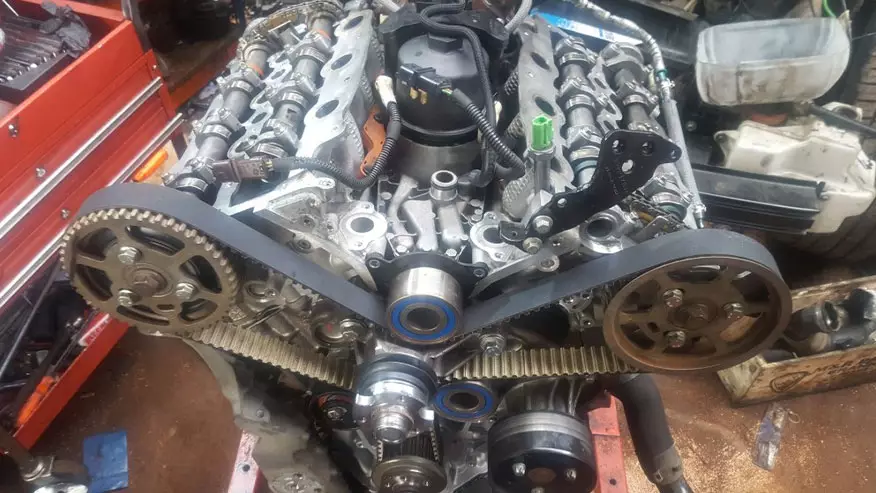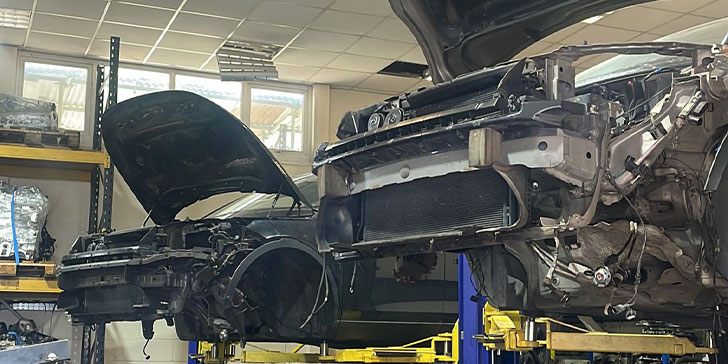Land Rover Discovery 3 Buyer’s Guide: Essential Tips for a Wise Investment

The Land Rover Discovery 3, a vehicle synonymous with robustness and luxury, offers a unique blend of off-road prowess and on-road comfort. This guide is crafted to navigate potential buyers through the crucial aspects of purchasing a used Discovery 3. Understanding what to look for, from the engine’s performance to the vehicle’s overall condition, is essential in making an informed decision. The Land Rover Discovery 3 engine, a key component, demands particular attention, as it is the heart of the vehicle, providing the power and reliability the brand is known for.
History
The Land Rover Discovery 3 stormed onto the UK scene in 2004, impressing with its modern design, spaciousness, and tech like air suspension and Terrain Response. Initially powered by 2.7 TDV6 diesel and 4.0 V6 petrol, it evolved in 2007 with a facelift, new engines like the 3.0 TDV6, and even more luxury. Popular in the used car market for its durability and versatility, it left a lasting impact on Land Rover, influencing future models while its strong owner community keeps its spirit alive. Despite potential pitfalls like air suspension issues, the Discovery 3 remains a beloved classic, forever linked to British adventure and the iconic Land Rover legacy.
Understanding the Land Rover Discovery 3 Engine
The engine is a crucial component of the Land Rover Discovery 3, known for its power and durability. Early models are equipped with a 4.4-litre V8 petrol engine or a 2.7-litre TDV6 diesel engine, each offering a distinct driving experience. The petrol engine is known for its smooth power delivery and refined performance, ideal for those who prioritise acceleration and smooth highway cruising. On the other hand, the diesel variant is celebrated for its torque and efficiency, making it a preferred choice for towing and off-road adventures.

Over the years, the Land Rover Discovery 3 engine underwent several enhancements, improving performance and reliability. Potential buyers should be aware of the common issues associated with these engines, such as the diesel’s potential for turbo problems and the petrol’s higher fuel consumption. Regular maintenance history is a good indicator of a well-cared-for engine, so always request service records. Additionally, a thorough mechanical inspection by a qualified technician can reveal any underlying issues that might not be immediately apparent.
Trim Levels and Features
When considering a Land Rover Discovery 3, it’s important to understand the various trim levels and their accompanying features. The base model, often referred to as the ‘S’ trim, offers essential features like air conditioning, electric windows, and a decent sound system. Moving up, the ‘SE’ trim adds enhancements such as leather seats, a better audio system, and additional exterior styling elements. For those seeking the ultimate in luxury and convenience, the ‘HSE’ trim provides premium features like satellite navigation, enhanced interior materials, and advanced safety features.
Choosing the right trim level depends on your personal preferences and requirements. If off-road capability and basic comfort are your primary concerns, the ‘S’ or ‘SE’ trims should suffice. However, if you desire a more luxurious driving experience with all the bells and whistles, the ‘HSE’ trim would be the best choice. Remember, higher trim levels will generally command a higher price, both in terms of initial purchase and potential maintenance costs.
Off-Road Capabilities
The Land Rover Discovery 3 is renowned for its exceptional off-road capabilities. Equipped with Land Rover’s Terrain Response system, it allows drivers to select from various modes that optimise the vehicle’s settings for different off-road conditions, such as mud, sand, or rocks. This system, combined with the vehicle’s sturdy construction and high ground clearance, makes the Discovery 3 an excellent choice for adventurous off-roaders or anyone needing to traverse challenging terrains.

However, it’s important to check for signs of excessive off-road use, such as underbody damage or worn suspension components. While the Discovery 3 is built to handle rough conditions, significant off-road use can lead to increased wear and tear. If you’re planning to use the vehicle predominantly for off-road adventures, consider investing in additional protective equipment like underbody guards and upgraded suspension parts to ensure its longevity and performance.
Safety and Reliability
Safety and reliability are key considerations when purchasing a used vehicle, and the Land Rover Discovery 3 scores well in both areas. It comes equipped with multiple airbags, anti-lock brakes, and electronic stability control, providing peace of mind for families and safety-conscious buyers. Additionally, its robust build quality contributes to a sense of security, particularly in challenging driving conditions.
However, potential buyers should be aware of certain reliability issues that have been reported with the Discovery 3. Electrical problems and air suspension issues are among the most common complaints. Therefore, it’s crucial to check the vehicle’s service history for any recurring issues and ensure that any known problems have been addressed. A pre-purchase inspection by a specialist can identify potential future problems, helping you avoid costly repairs down the line.
Fuel Efficiency
Fuel efficiency is an important factor to consider, especially given the size and engine options of the Land Rover Discovery 3. The petrol engine, while offering smoother performance, is less fuel-efficient compared to the diesel variant. On average, the diesel engine provides better mileage, making it a more economical choice for long-distance drivers or those who use their vehicles frequently.
Keep in mind that driving habits and maintenance play significant roles in fuel efficiency. Regular servicing, proper tyre inflation, and mindful driving can help optimise fuel consumption. Additionally, consider the type of driving you’ll be doing most often – city driving tends to consume more fuel due to stop-start traffic, whereas highway driving usually allows for better fuel economy.
Pricing and Value for Money
The pricing of a used Land Rover Discovery 3 can vary widely based on factors such as age, mileage, condition, and trim level. Generally, older models with higher mileage will be more affordable, but they may also come with higher maintenance costs. On the other hand, well-maintained, lower-mileage models will command a premium but could offer better value in the long run due to fewer required repairs and greater reliability.
When assessing value for money, consider the vehicle’s overall condition, service history, and any additional features or upgrades. A Discovery 3 with a full-service history, for example, is likely to be a more reliable investment than one with sporadic or unknown maintenance records. Additionally, aftermarket upgrades like enhanced off-road capabilities or improved interior features can add value, but be sure they are professionally installed and suitable for your needs.
Maintenance and Upkeep
Maintaining a Land Rover Discovery 3 is crucial for ensuring its longevity and performance. Regular maintenance, including oil changes, filter replacements, and brake inspections, should be adhered to as per the manufacturer’s recommendations. Additionally, given the vehicle’s complexity, particularly with its air suspension and electrical systems, it’s advisable to have a specialist or a mechanic familiar with Land Rovers perform the maintenance.

When purchasing a used Discovery 3, check for a comprehensive service history to ensure the vehicle has been well-maintained. Be prepared for potentially higher maintenance costs compared to less complex vehicles, especially for models with higher mileage or those that have been used extensively off-road. Investing in regular upkeep can prevent more costly repairs in the future and ensure the vehicle’s reliability.
Interior Comfort and Design
The interior of the Land Rover Discovery 3 is designed for comfort and functionality. Even in the base models, the cabin is spacious and well-appointed, with quality materials and a layout that is both practical and elegant. Higher trim levels offer additional luxuries like leather upholstery, power-adjustable seats, and advanced climate control, enhancing the overall driving experience.
When inspecting a used Discovery 3, pay close attention to the condition of the interior. Look for signs of wear and tear on the seats, steering wheel, and other frequently used areas. Check the functionality of all electronic components, including the climate control system, infotainment system, and power features. A well-maintained interior not only speaks to the vehicle’s overall condition but also contributes to a more enjoyable driving experience.
Technology and Infotainment
Technology and infotainment are important aspects of modern vehicles, and the Land Rover Discovery 3 offers a respectable array of features, especially in higher trim levels. Standard features typically include a basic audio system and connectivity options, while higher trims offer upgraded sound systems, navigation, and more sophisticated infotainment options.
It’s essential to test all technological features during your inspection, including the responsiveness of the touchscreen (if equipped), the quality of the sound system, and the functionality of any integrated navigation system. Keep in mind that technology can become dated, so evaluate whether the available features meet your current needs and preferences.
Resale Value and Depreciation
Like most vehicles, the Land Rover Discovery 3 will depreciate over time. However, well-maintained models with a full-service history and in good condition tend to hold their value better than those with a spotty maintenance record or significant wear and tear. The vehicle’s reputation for durability and off-road capability also supports its resale value.
When considering the purchase of a Discovery 3, think about how long you plan to keep the vehicle and how its depreciation might affect its future resale value. Models with popular features, such as diesel engines or higher trim levels, may be more desirable in the used market, potentially offering a better return on your investment when it’s time to sell. Buying a Land Rover Discovery 3 can be a rewarding experience if done with careful consideration and research. By understanding the key aspects of the vehicle, from its engine performance and off-road capabilities to its interior comfort and potential resale value, you can make a well-informed decision. Remember to prioritize maintenance history, conduct thorough inspections, and consider your personal needs and preferences to ensure a smart purchase.


